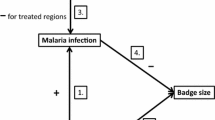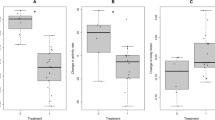Abstract
The causes of population cycles fascinate and perplex ecologist. Most work have focused on single processes, whether extrinsic or intrinsic, more rarely on how different processes might interact to cause or mould the unstable population dynamics. In red grouse (Lagopus lagopus scoticus), two causal mechanisms have been supported: territorial behaviour (changes in autumn aggressiveness) and parasites (parasite induced reduction in fecundity). Here, we report on how these two regulatory processes might interact, by testing whether the parasite suspected to cause the grouse cycles, the nematode Trichostrongylus tenuis, reduces male autumn territorial behaviour. We either treated males with an anthelmintic, to remove parasites (dosed or D-males), or challenged them with infective T. tenuis larvae, to increase parasite intensity (challenged or C-males). We first show that dosing was effective in removing T. tenuis parasites, while parasite intensities increased in challenged birds during the autumn. Because old males initially had more parasites than young males, the treatments generated greater differences in parasite intensity in old than in young males. We also show that various aspects of territorial behaviour (increase in testosterone-dependent comb size in autumn, territorial call rate, likelihood of winning territorial interactions and over-winter survival) were significantly higher in dosed than in challenged males, but in old birds only. Our data thus supported the hypothesis that parasites reduce male aggressiveness during the autumn territorial contests, and could thereby influence recruitment. Our results also highlight that the territorial behaviour of young males, which have fewer parasites, is not as limited by parasites as that of old, previously territorial males. We discuss the implications of these findings for our understanding of the processes regulating red grouse populations and causing their complex, unstable population dynamics.


Similar content being viewed by others
References
Berryman AA (2002) Population cycles: the case for trophic interactions. Oxford University Press, Oxford
Cramp S, Simmons KEL (1980) The birds of the western palearctic, vol 2. Oxford University Press, Oxford
Dobson AP, Hudson PJ (1992) Regulation and stability of a free-living host-parasite system—Trichostrongylus tenuis in red grouse. II. Population models. J Anim Ecol 61:487–498
Folstad I, Karter AJ (1992) Parasites, bright males, and the immunocompetence handicap. Am Nat 139:603–622
Fox A, Hudson PJ (2001) Parasites reduce territorial behaviour in red grouse (Lagopus lagopus scoticus). Ecol Lett 4:139–143
Haydon DT, Shaw DJ, Cattadori IM, Hudson PJ, Thirgood SJ (2002) Analysing noisy time-series: describing regional variation in the cyclic dynamics of red grouse. Proc R Soc Lond B 269:1609–1617
Hillgarth N, Wingfield JC (1997) Parasite-mediated sexual selection: endocrine aspects. In: Clayton DH, Moore J (eds) Host-parasite evolution. General Principles and Avian Models. Oxford University Press, Oxford, pp 78–104
Hudson PJ (1986) The red grouse: the biology and management of a wild gamebird. The Game Conservancy Trust, Fordingbridge
Hudson PJ, Newborn D, Dobson AP (1992) Regulation and stability of a free-living host-parasite system—Trichostrongylus tenuis in red grouse. I. Monitoring and parasite reduction experiments. J Anim Ecol 61:477–486
Hudson PJ, Dobson AP (1997) Transmission dynamics and host-parasite interactions of Trichostrongylus tenuis in red grouse (Lagopus lagopus scoticus). J Parasitogy 83:194–202
Hudson PJ, Dobson AP, Newborn D (1998) Prevention of population cycles by parasite removal. Science 282:2256–2258
Hudson PJ et al. (2002) Trophic interactions and population growth rates: describing patterns and identifying mechanisms. Phil Trans R Soc Lond B357:1259–1271
Klemola T, Koivula M, Korpimaki E, Norrdahl K (2000) Experimental tests of predation and food hypotheses for population cycles of voles. Proc R Soc Lond B 267:351–356
Krebs CJ et al. (1995) Impact of food and predation on the snowshoe hare cycle. Science 269:1112–1115
MacColl ADC, Piertney SB, Moss R, Lambin X (2000) Spatial arrangement of kin affects recruitment success in young male red grouse. Oikos 90:261–270
Matthiopoulos J, Moss R, Lambin X (1998) Models of red grouse cycles: a family affair? Oikos 82:574–590
Matthiopoulos J, Moss R, Mougeot F, Lambin X, Redpath SM (2003) Territorial behaviour and population dynamics in red grouse Lagopus lagopus scoticus. II. Population models. J Anim Ecol 72:1083–1096
Matthiopoulos J, Halley J.M., Moss R (2005) Socially-induced population cycles in red grouse require abrupt transitions between tolerant and aggressive behaviour. Ecology (in press)
Moss R et al (1979) Aggressiveness and dominance in captive cock red grouse. Aggr Behav 5:58–84
Moss R, Watson A, Parr R (1988) Mate choice by hen red grouse Lagopus lagopus with an excess of cocks—role of territory size and food quality. Ibis 130:545–552
Moss R, Trenholm IB, Watson A, Parr R (1990) Parasitism, predation and survival of hen red grouse Lagopus lagopus scoticus in spring. J Anim Ecol 59:631–642
Moss R, Watson A (2001) Population cycles in birds of the grouse family (Tetraonidae). Adv Ecol Res 32:53–111
Mougeot F, Redpath SM, Leckie F, Hudson PJ (2003a) The effect of aggressiveness on the population dynamics of a territorial bird. Nature 421:737–739
Mougeot F, Redpath SM, Moss R, Matthiopoulos J, Hudson PJ (2003b) Territorial behaviour and population dynamics in red grouse Lagopus lagopus scoticus. I. Population experiments. J Anim Ecol 72:1073–1082
Mougeot F, Redpath S (2004) Sexual ornamentation relates to immune function in male red grouse Lagopus lagopus scoticus. J Avian Biol 35:425–433
Mougeot F, Irvine J, Seivwright LJ, Redpath S, Piertney SB (2004) Testosterone, immunocompetence and honest sexual signaling in male red grouse. Behav Ecol 15:630–637
Mougeot F, Dawson A, Redpath S, Leckie F (2005a) Testosterone and autumn territorial behaviour in male red grouse Lagopus lagopus scoticus. Horm Behav (in press)
Mougeot F, Piertney S, Leckie F, Evans S, Moss R, Redpath S, Hudson PJ (2005b) Experimentally increased aggressiveness reduces population kin structure and subsequent recruitment in red grouse Lagopus lagopus scoticus. J Anim Ecol (in press)
Mountford MD, Watson A, Moss R, Parr R, Rothery P (1990) Land inheritance and population cycles of red grouse. In: Lance AN, Lawton JH (eds) Red Grouse Population Processes. Royal Society for the Protection of Birds, Sandy, Bedfordshire, pp 78–83
Packer C, Holt RD, Hudson PJ, Lafferty KD, Dobson AP (2003) Keeping the herds healthy and alert: implications of predator control for infectious disease. Ecol Lett 6:797–802
Park KJ, Hurley MM, Hudson PJ (2002) Territorial status and survival in red grouse Lagopus lagopus scoticus: hope for the doomed surplus? J Avian Biol 33:56–62
Peters A, Delhey K, Denk AG, Kempenaers B (2004) Trade-offs between immune investment and sexual signaling in male mallards. Am Nat 164:51–59
SAS (2001) SAS/STAT User’s guide, version 8.01. SAS Insitute Inc., Cary
Seivwright LJ (2004) Pattern of Trichostrongylus tenuis infection in individual red grouse Lagopus lagopus scoticus. PhD dissertation. University of Stirling
Seivwright LJ, Redpath S, Mougeot F, Watt L, Hudson PJ (2004) Faecal egg counts provide a reliable measure of Trichostrongylus tenuis intensities in free-living red grouse Lagopus lagopus scoticus. J Helm 78:69–76
Seivwright LJ, Redpath S, Mougeot F, Leckie F, Hudson PJ (2005) Interactions between population processes in a cyclic species: testosterone increases parasite intensity, (submitted)
Shaw JL (1988) Arrested development of Trichostrongylus tenuis as 3rd stage larvae in red grouse. Res Vet Sci 45:256–258
Sheldon BC, Verhulst S (1996) Ecological immunology: costly parasite defences and trade-offs in evolutionary ecology. Trends Ecol Evol 11:317–321
Stenseth NC, Bjornstad ON, Falck W (1996) Is spacing behaviour coupled with predation causing the microtine density cycle? A synthesis of current process-oriented and pattern-oriented studies. Proc R Soc Lond B 263:1423–1435
Turchin P (2003) Complex population dynamics: a theoritical/empirical synthesis. University Press, Princeton
Verhulst S, Dieleman SJ, Parmentier HK (1999) A trade-off between immunocompetence and sexual ornamentation in domestic fowl. PNAS 96:4478–4481
Watson A (1985) Social class, socially-induced loss, recruitment and breeding of red grouse. Oecologia 67:493–498
Watson A, Jenkins D (1964) Notes on the behaviour of red grouse. Br Birds 57:137–170
Watson A, Miller GR (1971) Territory size and aggression in a fluctuating red grouse population. J Anim Ecol 40:367–383
Watson A, Moss R, Parr R, Mountford MD, Rothery P (1994) Kin landownership, differential aggression between kin and non-kin, and population fluctuations in red grouse. J Anim Ecol 63:39–50
Wilson GR, Wilson LP (1978) Haematology, weight and condition of captive red grouse (Lagopus lagopus scoticus) infected with caecal threadworm (Trichostrongylus tenuis). Res Vet Sci 25:331–336
Acknowledgements
We are grateful to the landowner and keepers of the Edinglassie estate for allowing us to conduct the work on this moor. Particular thanks are due to D. Calder for his help with organising the fieldwork. We also thank G. Jones, E. Kleun and F. Leckie for their help with the fieldwork. We also thank P.J. Hudson for his help with the experimental design, R. Moss and two anonymous referees for comments on the manuscript. This work was funded by a NERC grant (NER/A/S/1999/00074). The experiments comply with the current laws of the UK and were carried out under Home Office licence (PPL 80/1437).
Author information
Authors and Affiliations
Corresponding author
Additional information
Communicated by Roland Brandl
Rights and permissions
About this article
Cite this article
Mougeot, F., Evans, S.A. & Redpath, S.M. Interactions between population processes in a cyclic species: parasites reduce autumn territorial behaviour of male red grouse. Oecologia 144, 289–298 (2005). https://doi.org/10.1007/s00442-005-0080-x
Received:
Accepted:
Published:
Issue Date:
DOI: https://doi.org/10.1007/s00442-005-0080-x




